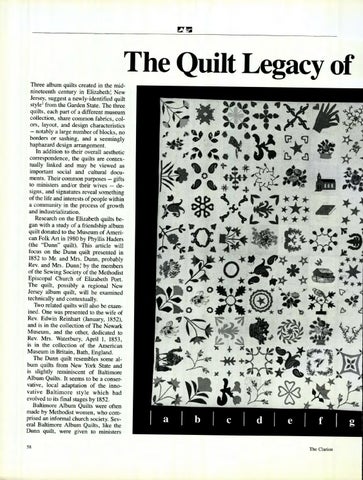The Quilt Legacy of Three album quilts created in the midnineteenth century in Elizabeth; New Jersey, suggest a newly-identified quilt style'from the Garden State. The three quilts, each part of a different museum collection, share common fabrics, colors, layout, and design characteristics — notably a large number of blocks, no borders or sashing, and a seemingly haphazard design arrangement. In addition to their overall aesthetic correspondence, the quilts are contextually linked and may be viewed as important social and cultural documents. Their common purposes — gifts to ministers and/or their wives — designs, and signatures reveal something of the life and interests of people within a community in the process of growth and industrialization. Research on the Elizabeth quilts began with a study of a friendship album quilt donated to the Museum of American Folk Art in 1980 by Phyllis Haders (the "Dunn" quilt). This article will focus on the Dunn quilt presented in 1852 to Mr. and Mrs. Dunn, probably Rev. and Mrs. Dunn, by the members of the Sewing Society of the Methodist Episcopal Church of Elizabeth Port. The quilt, possibly a regional New Jersey album quilt, will be examined technically and contextually. Two related quilts will also be examined. One was presented to the wife of Rev. Edwin Reinhart (January, 1852), and is in the collection of The Newark Museum, and the other, dedicated to Rev. Mrs. Waterbury, April 1, 1853, is in the collection of the American Museum in Britain, Bath, England. The Dunn quilt resembles some album quilts from New York State and is slightly reminiscent of Baltimore Album Quilts. It seems to be a conservative, local adaptation of the innovative Baltimore style which had evolved to its final stages by 1852. Baltimore Album Quilts were often made by Methodist women, who comprised an informal church society. Several Baltimore Album Quilts, like the Dunn quilt, were given to ministers 58
The Clarion
